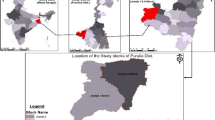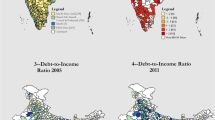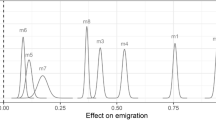Abstract
The adverse effects of climate change are likely to harm agricultural livelihoods and food supplies worldwide. Faced with challenges resulting from increasingly unpredictable weather patterns, some farmers might abandon their occupations. Existing research has found that drier than usual weather reduces landownership rates through these pathways. Such trends could be disruptive at a population level, threatening a country’s economic and political stability. We analyze subnational agricultural landownership data that cover 50 countries on four continents between 2004 and 2017. Our Demographic and Health Surveys (DHS) dataset speaks to the experiences of 1,123,714 households. Our predictor of environmental stress is the growing season standardized precipitation-evapotranspiration index, which measures deviations from local weather patterns dating back to 1901. We find that drier than average growing season weather is associated with declining landownership rates. For every dry growing season before a DHS survey, the agricultural landownership rate falls by 2.51%. This effect is most robust in African countries, which was the focus of a recent study on this topic, and we offer several plausible interpretations of these regional differences.




Similar content being viewed by others
Data availability
Replication files for the analysis producing our results are available on the corresponding authors Harvard dataverse page.
Notes
-
There is a problematic data generating process in Peru, where DHS gathered data 6 times between 2004 and 2012. One- or two-year intervals for measuring the dependent variable results in overlapping measurement of the key environmental stress-independent variable. While the landownership question was asked in Peru, it is the only country that we exclude from our analysis.
References
Abbott, J. (2019). ‘No other option’: Climate change driving many to flee Guatemala. Migration | Al Jazeera. Retrieved February 2, 2022, from https://www.aljazeera.com/features/2019/5/13/no-other-option-climate-change-driving-many-to-flee-guatemala
Abel, G. J., Brottrager, M., Cuaresma, J. C., & Muttarak, R. (2019). Climate, conflict and forced migration. Global Environmental Change, 54, 239–249.
Afifi, T., Liwenga, E., & Kwezi, L. (2014). Rainfall-induced crop failure, food insecurity and out-migration in Same-Kilimanjaro. Tanzania. Climate and Development, 6(1), 53–60.
Agbonlahor, M., & Phillip, D. O. A. (2015). Deciding to settle: Rural-rural migration and agricultural labour supply in southwest Nigeria. The Journal of Developing Areas, 49(1), 267–284.
Al, Jazeera. (2021). Climate now a worse crisis than war for Afghanistan’s farmers. Gallery News | Al Jazeera. Retrieved February 2, 2022, from https://www.aljazeera.com/gallery/2021/10/26/photos-afghanistan-climate-change-farmers-cop26-agriculture
Amrhein, V., Greenland, S., & McShane, B. (2019). Scientists rise up against statistical significance. Nature, 567, 305–307.
Atiah, W. A., Amekudzi, L. K., Akum, R. A., Quansah, E., Antwi-Agyei, P., & Danuor, S. K. (2021). Climate variability and impacts on maize (Zea Mays) yield in Ghana, West Africa. Quarterly Journal of the Royal Meteorological Society. https://doi.org/10.1002/qj.4199
Ayeb-Karlsson, S. (2020). When the disaster strikes: Gendered (im)mobility in Bangladesh. Climate Risk Management., 29, 100237.
Baffour-Ata, F., Antwi-Agyei, P., Nkiaka, E., Dougill, A. J., Anning, A. K., & Kwakye, S. O. (2021). Effect of climate variability on yields of selected staple food crops in northern Ghana. Journal of Agriculture and Food Research, 6, 100205.
Beine, M., & Parsons, C. (2015). Climatic factors as determinants of international migration. The Scandinavian Journal of Economics, 117(2), 723–767.
Berlemann, M., & Steinhardt, M. F. (2017). Climate change, natural disasters, and migration—A survey of the empirical evidence. Cesifo Economic Studies, 63(4), 353–385.
Besag, J. E. (1972). Nearest-neighbour systems and the auto-logistic model for binary data. Journal of the Royal Statistical Society: Series B (methodological), 34(1), 75–83.
Black, R., Arnell, N. W., Adger, W. N., Thomas, D., & Geddes, A. (2013). Migration, immobility and displacement outcomes following extreme events. Environmental Science & Policy, 27(1), S32–S43.
Black, R., Bennett, S. R. G., Thomas, S. M., & Beddington, J. R. (2011). Migration as adaptation. Nature, 478, 447–449.
Black, R., & Collyer, M. (2014). Populations ‘trapped’ at times of crisis. Forced Migration Review, 45, 52–56.
Bohra-Mishra, P., Oppenheimer, M., & Hsiang, S. M. (2014). Nonlinear permanent migration response to climate variations but minimal response to disasters. Proceedings of the National Academy of Sciences, 111(27), 9780–9785.
Borrelli, P., Robinson, D. A., Panagos, P., Lugato, E., Yang, J. E., Alewell, C., & Ballabio, C. (2020). Land use and climate change impacts on global soil erosion by water (2015–2070). Proceedings of the National Academy of Sciences, 117(36), 21994–22001.
Brzoska, M., & Fröhlich, C. (2016). Climate change, migration and violent conflict: Vulnerabilities, pathways and adaptation strategies. Migration and Development, 5(2), 190–210.
Burke, M., Hsiang, S. M., & Miguel, E. (2015). Global non-linear effect of temperature on economic production. Nature, 527(7577), 235–239.
Carasik, L. (2017). Investing in murder: Honduran farmers sue World Bank’s lending arm for fueling land conflict. World Policy Journal, 34(2), 24–30.
Cattaneo, C., Beine, M., Fröhlich, C. J., Kniveton, D., Martinez-Zarzoso, I., Mastrorillo, M., & Schraven, B. (2019). Human migration in the era of climate change. Review of Environmental Economics and Policy, 13(2), 189–206.
Cattaneo, C., & Bosetti, V. (2017). Climate-induced international migration and conflicts. Cesifo Economic Studies, 63(4), 500–528.
Cattaneo, C., & Peri, G. (2016). The migration response to increasing temperatures. Journal of Development Economics, 122, 127–146.
Dasgupta, S., Hossain, M. M., Huq, M., & Wheeler, D. (2015). Climate change and soil salinity: The case of coastal Bangladesh. Ambio, 44(8), 815–826.
De Haas, H. (2005). International migration, remittances and development: Myths and facts. Third World Quarterly, 26(8), 1269–1284.
De Jong, G. (2000). Expectations, gender, and norms in migration decision-making. Population Studies, 54(3), 307–319.
Deininger, K. (2003). Land policies for growth and poverty reduction. World Bank Policy Research Report. World Bank and Oxford University Press.
Démurger, S. (2015). Migration and families left behind: Families that stay behind when a member migrates do not clearly benefit. Institute of Labor Economics (IZA) working paper. University of Bonn. Accessed, 12/1/2022. Available: https://wol.iza.org/uploads/articles/144/pdfs/migration-and-families-left-behind.pdf?v=1
DHS (2021). The DHS program spatial data repository. Funded by USAID. spatialdata.dhsprogram.com. [Accessed August, 19, 2021].
Do, Q. T., & Iyer, L. (2009). Geography, poverty and conflict in Nepal. Journal of Peace Research, 47(6), 735–748.
Douma, P. (2006). Poverty, relative deprivation and political exclusion as drivers of violent conflict in Sub Saharan Africa. ISYP Journal on Science and World Affairs, 2(2), 59–69.
Falco, C., Galeotti, M., & Olper, A. (2019). Climate change and migration: Is agriculture the main channel? Global Environmental Change, 59, 101995.
Fan, C. C. (2021). Householding and split households: Examples and stories of Asian migration to cities. Cities, 113, 103147.
Findley, S. E. (1994). Does drought increase migration? A study of migration from rural Mali during the 1983–1985 drought. The International Migration Review, 28(3), 539–553.
Frelat, R., Lopez-Ridaura, S., Giller, K. E., Hererro, M., Douxchamps, S., Djurfeldt, A. A., & van Wijk, M. T. (2015). Drivers of household food availability in sub-Saharan Africa based on big data from small farms. Proceedings of the National Academy of Sciences, 113(2), 458–463.
Gray, C. L., & Mueller, V. (2012). Natural disasters and population mobility in Bangladesh. Proceedings of the National Academy of Sciences., 109(16), 6000–6005.
Griffith, D. A. (2003). Spatial filtering. Spatial Autocorrelation and Spatial Filtering (pp. 91–130). Springer.
Gröschl, J., & Steinwachs, T. (2017). Do natural hazards cause international migration? Cesifo Economic Studies, 63(4), 445–480.
Guri, F., Kapaj, I., Musabelliu, B., Meço, M., Topulli, E., Keco, R., ... & y Paloma, S. G. (2015). Characteristics of farming systems in Albania (No. JRC95833). Joint Research Centre (Seville site).
Gustin, G. (2020). Ravaged by drought, a Honduran village faces a choice: Pray for rain or migrate. Inside Climate News. Retrieved February 17, 2022, from https://insideclimatenews.org/news/08072019/climate-change-migration-honduras-drought-crop-failure-farming-deforestation-guatemala-trump/
Harris, I., Osborn, T. J., Jones, P., & Lister, D. (2020). Version 4 of the CRU TS monthly high-resolution gridded multivariate climate dataset. Scientific Data, 7(1), 1–18.
Hasegawa, T., Sakurai, G., Fujimori, S., Takahashi, K., Hijioka, Y., & Masui, T. (2021). Extreme climate events increase risk of global food insecurity and adaptation needs. Nature Food, 2, 587–595.
Hazell, P., Poulton, C., Wiggins, S., & Dorward, A. (2010). The future of small farms: Trajectories and policy priorities. World Development, 38(10), 1349–1361.
Herlihy, P. H., & Tappan, T. A. (2019). Recognizing indigenous miskitu territory in Honduras. Geographical Review, 109(1), 67–86.
Hoffmann, R., Dimitrova, A., Muttarak, R., Cuaresma, J. C., & Peisker, J. (2020). A meta-analysis of country-level studies on environmental change and migration. Nature Climate Change, 10(10), 904–912.
Ide, T., Brzoska, M., Donges, J. F., & Schleussner, C. F. (2020). Multi-method evidence for when and how climate-related disasters contribute to armed conflict risk. Global Environmental Change, 62, 102063.
IPCC. (2021) Climate change 2021: The physical science basis. Contribution of Working Group I to the Sixth Assessment Report of the Intergovernmental Panel on Climate Change [Masson-Delmotte, V., P. Zhai, A. Pirani, S. L. Connors, C. Péan, S. Berger, N. Caud, Y. Chen, L. Goldfarb, M. I. Gomis, M. Huang, K. Leitzell, E. Lonnoy, J. B. R. Matthews, T. K. Maycock, T. Waterfield, O. Yelekçi, R. Yu and B. Zhou (eds.)]. Cambridge University Press. In Press.
Jayne, T. S., Chamberlin, J., & Headey, D. D. (2014). Land pressures, the evolution of farming systems, and development strategies in Africa: A synthesis. Food Policy, 48, 1–17.
Jowit, J. (2008). Drought land ‘will be abandoned’. The Guardian, 1 November. Available: https://www.theguardian.com/environment/2008/nov/02/climate-change-desertification-water-drought
Kabubo-Mariara, J., & Karanja, F. K. (2007). The economic impact of climate change on Kenyan crop agriculture: A Ricardian approach. Global and Planetary Change, 57(3–4), 319–330.
Knox, J., Hess, T., Daccache, A., & Wheeler, T. (2012). Climate change impacts on crop productivity in Africa and South Asia. Environmental Research Letters, 7(3), 034032.
Lee, E. S. (1966). A theory of migration. Demography, 3(1), 47–57.
Leiber, M., Chin-Hong, P., Kelly, K., Dandu, M., & Weiser, S. D. (2020). A systematic review and meta-analysis assessing the impacts of droughts, flooding, and climate variability on malnutrition. Global Public Health, 17(1), 68–82.
Lerman, Z. (2006). The impact of land reform on rural household incomes in Transcaucasia. Eurasian Geography and Economics, 47(1), 112–123.
Lesk, C., Rowhani, P., & Ramankutty, N. (2016). Influence of extreme weather disasters on global crop production. Nature, 529(7584), 84–87.
Lindgren, F., & Rue, H. (2015). Bayesian spatial modelling with R-INLA. Journal of Statistical Software, 63(19), 1–25.
Linke, A. M., & Tollefsen, A. F. (2021). Environmental stress and agricultural landownership in Africa. Global Environmental Change, 67, 102237.
Linke, A. M., Witmer, F. D., O’Loughlin, J., McCabe, J. T., & Tir, J. (2018). The consequences of relocating in response to drought: Human mobility and conflict in contemporary Kenya. Environmental Research Letters, 13(9), 094014.
Lowder, S. K., Sanchez, M. V., & Bertini, R. (2021). Which farms feed the world and has farmland become more concentrated? World Development, 142, 105455.
Lowder, S. K., Skoet, J., & Raney, T. (2016). The number, size, and distribution of farms, smallholder farms, and family farms worldwide. World Development, 87, 16–29.
Malik, S. M. (2011). An empirical investigation of the relationship between food insecurity, landlessness, and violent conflict in Pakistan. Pakistan Institute of Development Economics. Working paper 71. Islambad, Pakistan. Accessed 20 June 2022. Available: https://core.ac.uk/download/pdf/6489617.pdf
McLeman, R., & Gemenne, F. (Eds.). (2018). Routledge handbook of environmental displacement and migration. Routledge
Missirian, A., & Schlenker, W. (2017). Asylum applications respond to temperature fluctuations. Science, 358(6370), 1610–1614.
Mueller, V., Gray, C., & Kosec, K. (2014). Heat stress increases long-term human migration in rural Pakistan. Nature Climate Change, 4(3), 182–185.
Mulungu, K., & Tembo, G. (2015). Effects of weather variability on crop abandonment. Sustainability, 7(3), 2858–2870.
Nébié, E. K. I., & West, C. T. (2019). Migration and land-use/land-cover change in Burkina Faso: A comparative case study. Journal of Political Ecology, 26(1), 614–632.
Nordkvelle, J., Rustad, S. A., & Salmivalli, M. (2017). Identifying the effect of climate variability on communal conflict through randomization. Climatic Change, 141, 627–639.
Park, Y. M., & Kim, Y. (2014). A spatially filtered multilevel model to account for spatial dependency: Application to self-rated health status in South Korea. International Journal of Health Geographics, 13(1), 1–10.
Pérez-Hoyos, A. (2018): Global crop and rangeland masks. European Commission, Joint Research Centre PID: http://data.europa.eu/89h/jrc-10112-10005
Ray, D. K., Gerber, J. S., MacDonald, G. K., & West, P. C. (2015). Climate variation explains a third of global crop yield variability. Nature Communications, 6(1), 1–9.
Rembold, F., Meroni, M., Urbano, F., Csak, G., Kerdiles, H., Pérez-Hoyos, A., & Negre, T. (2019). ASAP: A new global early warning system to detect anomaly hot spots of agricultural production for food security analysis. Agricultural Systems, 168, 247–257.
Riosmena, F., Nawrotzki, R., & Hunter, L. (2018). Climate migration at the height and end of the great Mexican emigration era. Population Development Review, 44, 455–488.
Rodríguez, G. (2011). Bajo Aguán, Honduras: History of rural poverty turns dramatically violent in region where wealthy landowners impose their will. Accessed 9 June, 2022. Available: https://digitalrepository.unm.edu/cgi/viewcontent.cgi?article=10928&context=noticen
Rue, H., Martino, S., & Chopin, N. (2009). Approximate Bayesian inference for latent Gaussian models by using integrated nested Laplace approximations. Journal of the Royal Statistical Society: Series B, 71(2), 319–392.
Samberg, L. H., Gerber, J. S., Ramankutty, N., Herrero, M., & West, P. C. (2016). Subnational distribution of average farm size and smallholder contributions to global food production. Environmental Research Letters, 11(12), 124010.
Schutte, S., Vestby, J., Carling, J., & Buhaug, H. (2021). Climatic conditions are weak predictors of asylum migration. Nature Communications, 12(1), 1–10.
Stuch, B., Alcamo, J., & Schaldach, R. (2019). Projected climate change impacts on mean and year-to-year variability of yield of key smallholder crops in sub-Saharan Africa. Climate and Development, 13(3), 268–282.
Suhrke, A. (1994). Environmental degradation and population flows. Journal of International Affairs, 47(2), 473–496.
Sultan, B., Defrance, D., & Iizumi, T. (2019). Evidence of crop production losses in West Africa due to historical global warming in two crop models. Scientific Reports, 9(1), 1–15.
Thein, S., Diepart, J. C., Moe, H., & Allaverdian, C. (2018). Large-scale land acquisitions for agricultural development in Myanmar: A review of past and current processes. Mekong Region Land Governance report. Accessed 8 June, 2022, Available: https://www.mrlg.org/publications/large-scale-land-acquisitions-for-agricultural-development-in-myanmar-a-review-of-past-and-current-processes/
U.S. Environmental Protection Agency. (2021). Climate change indicators in the United States: Sea level. Accessed March, 2022. Available: https://www.epa.gov/climate-indicators/climate-change-indicators-sea-level
United Nations. (2016). The UNCCD: Securing life on land (2016–2017). United Nations Convention to Combat Desertification. Accessed December, 2022. Available: https://www.unccd.int/resources/publications/unccd-securing-life-land-2016-2017
Vestby, J. (2019). Climate variability and individual motivations for participating in political violence. Global Environmental Change, 56, 114–123.
Vicente-Serrano, S. M., Beguería, S., & López-Moreno, J. I. (2010). A multiscalar drought index sensitive to global warming: The standardized precipitation evapotranspiration index. Journal of Climate, 23(7), 1696–1718.
Wrathall, D. J., Bury, J., Carey, M., Mark, B., McKenzie, J., Young, K., & Rampini, C. (2014). Migration amidst climate rigidity traps: Resource politics and social-ecological possibilism in Honduras and Peru. Annals of the American Association of Geographers, 104, 292–304.
Funding
This study has been supported by the Research Council of Norway (grant no. 268135/E10CROP).
Author information
Authors and Affiliations
Contributions
All authors contributed to the study conception and design. Material preparation, data collection, and analysis were performed by Andrew Linke and Matthew Shawcraft. The first draft of the manuscript was written by both authors. All authors read and approved the final manuscript.
Corresponding author
Ethics declarations
Competing interests
The authors declare claim no competing interests.
Additional information
Publisher's Note
Springer Nature remains neutral with regard to jurisdictional claims in published maps and institutional affiliations.
Supplementary Information
Below is the link to the electronic supplementary material.
Rights and permissions
Springer Nature or its licensor (e.g. a society or other partner) holds exclusive rights to this article under a publishing agreement with the author(s) or other rightsholder(s); author self-archiving of the accepted manuscript version of this article is solely governed by the terms of such publishing agreement and applicable law.
About this article
Cite this article
Linke, A., Shawcroft, M. The effects of environmental stress on global agricultural landownership. Popul Environ 45, 19 (2023). https://doi.org/10.1007/s11111-023-00429-0
Accepted:
Published:
DOI: https://doi.org/10.1007/s11111-023-00429-0




